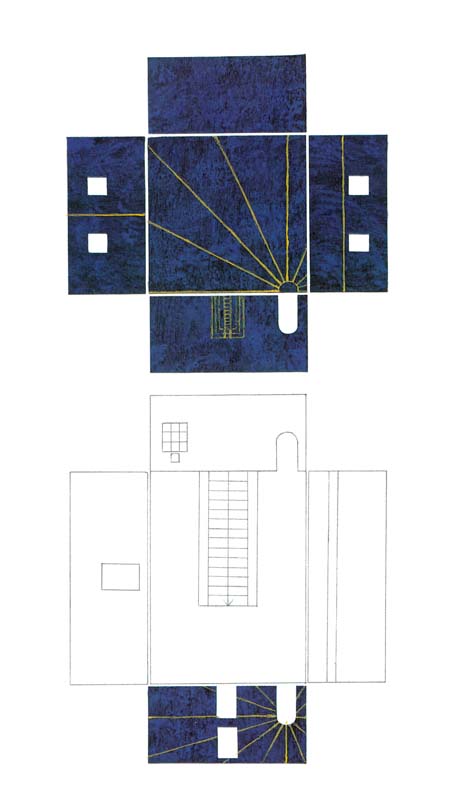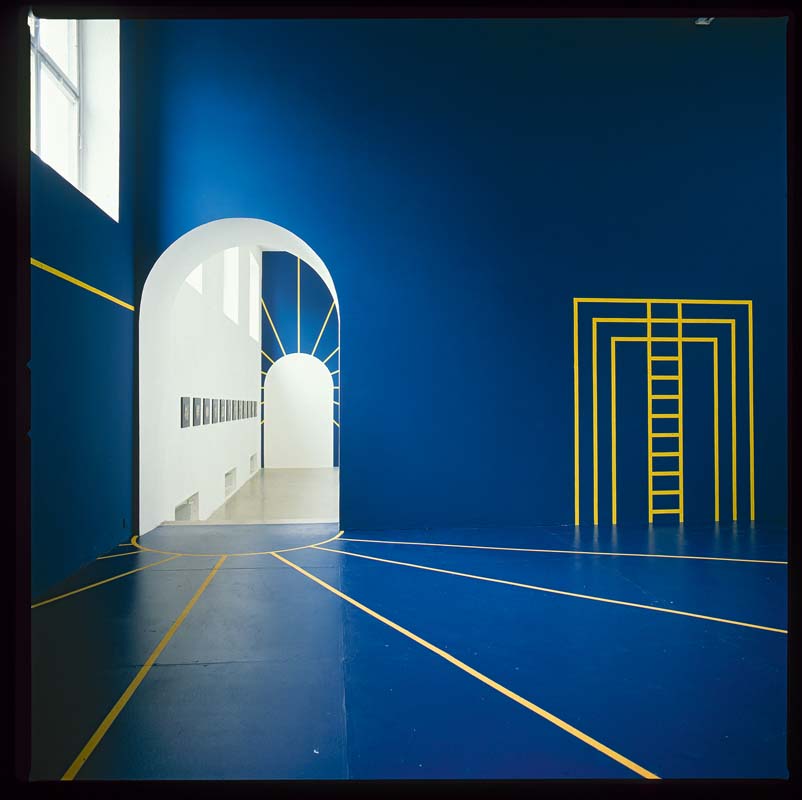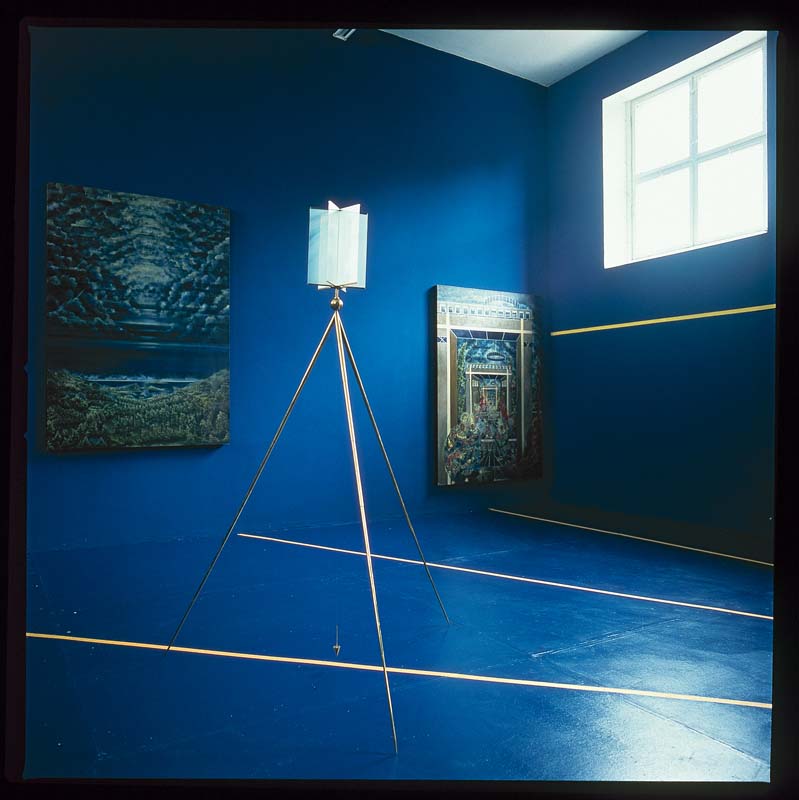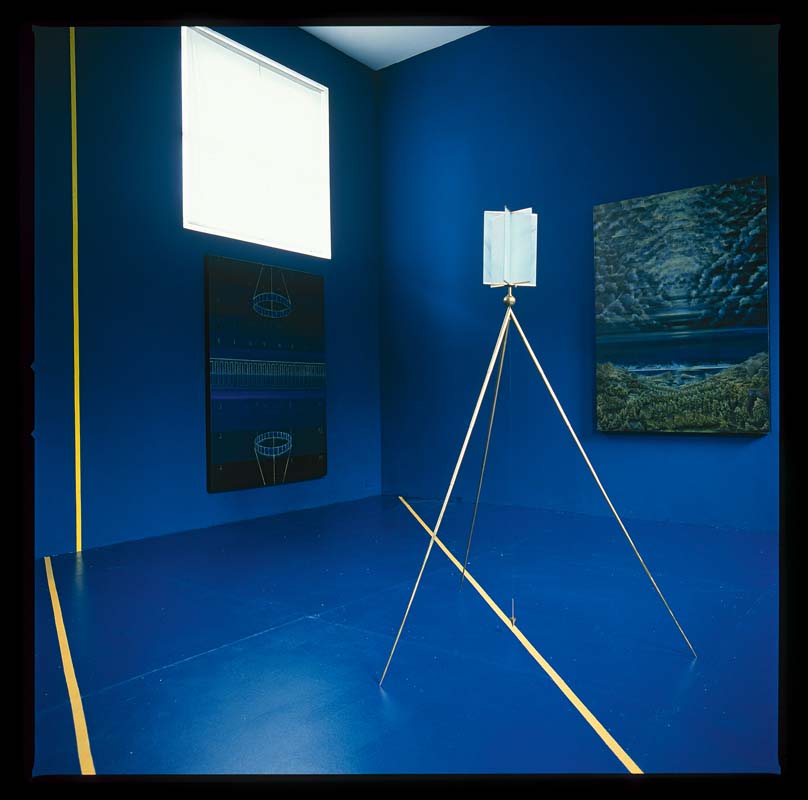Michael Kunze’s “Eine Welt” from 1990
 Twenty-three years ago, in 1990, the Munich Kunstverein put on a remarkable
exhibition.1 It was the first public appearance of the young painter Michael Kunze,
whose wall and floor paintings transformed the two rooms on the top story of the
building at the Hofgarten into an accessible stage dominated by the colors blue
and yellow. Hermetic pictures and curious cosmic symbols emerged as protagonists
on this stage, whose forms derived from sunbeams and planets indeed conveyed, in
conformity with the predominating color of the sky, the impression that an imaginary
cosmos was being evoked here. The title of the show selected by the artist—
“Eine Welt” [One World]—contributed to the fact that one did not think initially
about the concrete, perceptible world, but rather about another entity. The Munich
public as well as the critics largely responded to this draft with incomprehension
and disinterest, which is not surprising when one takes into consideration that
Kunze’s ideas stood diametrically opposed to the post-conceptual and contextual
positions that were widely disseminated at that time.
Twenty-three years ago, in 1990, the Munich Kunstverein put on a remarkable
exhibition.1 It was the first public appearance of the young painter Michael Kunze,
whose wall and floor paintings transformed the two rooms on the top story of the
building at the Hofgarten into an accessible stage dominated by the colors blue
and yellow. Hermetic pictures and curious cosmic symbols emerged as protagonists
on this stage, whose forms derived from sunbeams and planets indeed conveyed, in
conformity with the predominating color of the sky, the impression that an imaginary
cosmos was being evoked here. The title of the show selected by the artist—
“Eine Welt” [One World]—contributed to the fact that one did not think initially
about the concrete, perceptible world, but rather about another entity. The Munich
public as well as the critics largely responded to this draft with incomprehension
and disinterest, which is not surprising when one takes into consideration that
Kunze’s ideas stood diametrically opposed to the post-conceptual and contextual
positions that were widely disseminated at that time.
 But the fact that the installation’s partly gloomy, partly hermetic atmosphere
was not intended to convey some occult doctrine and that Kunze’s imaginary
worldview did, by all means, assume concrete forms, was clear to any viewer
who was conscious of the strong presence of the space defined by the two colors
and the complexity of the images and symbols. Incidentally, the artist made a
statement in the publication accompanying the exhibition that contains several
clues to an understanding of the title of his staging, albeit in an encrypted manner:
“For those who speak of one world in the sense of one of many possible worlds, the case seems
to be clear. He indeed believes that he knows the borders of this one world to the extent that he can
differentiate them from other possible worlds. But, by contrast, those who speak of one world in
the sense of a unique and unsurpassable ultimate world easily enmesh themselves in contradictions
that soon become the dominating theme involved in this speaking, to the extent that the thesis of the
ultimateness and comprehensiveness of one world poses the question regarding the path to such a
concept of totality.”2
But the fact that the installation’s partly gloomy, partly hermetic atmosphere
was not intended to convey some occult doctrine and that Kunze’s imaginary
worldview did, by all means, assume concrete forms, was clear to any viewer
who was conscious of the strong presence of the space defined by the two colors
and the complexity of the images and symbols. Incidentally, the artist made a
statement in the publication accompanying the exhibition that contains several
clues to an understanding of the title of his staging, albeit in an encrypted manner:
“For those who speak of one world in the sense of one of many possible worlds, the case seems
to be clear. He indeed believes that he knows the borders of this one world to the extent that he can
differentiate them from other possible worlds. But, by contrast, those who speak of one world in
the sense of a unique and unsurpassable ultimate world easily enmesh themselves in contradictions
that soon become the dominating theme involved in this speaking, to the extent that the thesis of the
ultimateness and comprehensiveness of one world poses the question regarding the path to such a
concept of totality.”2
That which sounds like a philosophical tractate is in reality a complex indication of the artist’s aspirations
to differentiate his intellectual world from an unbounded and consequently likewise arbitrarily interpretable
“residual world.” “It is the openly acknowledged ignorance about the borders of that ostensibly comprehensive
world that first makes speaking about it meaningful again and cuts the ground
from under its feet at the same time.”3 At this point at the latest, Kunze’s references to
German idealism and romanticism become visible—this can be substantiated when
viewing the paintings exhibited for the first time twenty-three years ago at the Munich
Kunstverein. One feels reminded of certain emblematic compositions by Philipp
Otto Runge, for example “The Small Morning” (1808), in which the poetic-symbolic
figurations implanted into an animated nature convey the artist’s pantheistic
worldview. A romantic topoi is also evoked by the strongly accentuated blue in the
installation. Runge and other romantic artists took the symbolic significance of the
vision of the “Blue Flower,” introduced to literature around 1800 by Novalis, as an expression of longing
and remoteness, but also as the symbol of womankind par excellence. The other color that likewise
has a strong presence in Kunze’s work, the complementary yellow, assumed the role of symbolizing
cosmic radiation and gravitational forces in the Munich staging.
the construction of “one world”

What was on show in the exhibition? Climbing the stairs from the ground floor to the first floor of the
Kunstverein, the visitor was initially confronted with a lush blue wall. To the left of the passageway leading
to the central hall, which was reserved for another show, one saw the virtual opening of an archway,
from which yellow rays were emitted in all directions. The false opening corresponded in size and form
to the actual passageway leading to the second hall on the other side of the space, where another part
of Kunze’s installation was to be found. This hall, including the floor, was painted completely blue,
whereby the yellow rays that were applied here too were inverted, in a manner of speaking, from the wall
to the floor. In addition two oil paintings, a wall painting suggestive of strict geometry and a tripod, the
upper part of which consisted of a glass fan, could also be seen in this room. Walking back to the middle
room, the visitor faced a series of small pictures affixed to wood panels that were painted blue and
depicted compositions of radiant dots and lines suggestive of mannerism.
All the sections of the installation referenced each other, and the more one viewed the whole,
the more it became evident that it involved a well-considered construction. Michael Kunze predetermined
the parameters of the construction in a ground plan that he published in the catalog, thus
revealing its rational structure. The spaces appear like two alternative drafts, the combination of which
resulted in a spatial connection. Even the staircase leading up to the exhibition was entered into the
draft by way of the geometrical wall painting. Vertically and horizontally arranged yellow rays ultimately
united the two sections to form an imaginary entity. Where there are constructions, there must
first be measuring devices. This function was assumed by the tripod that was set up as a “sculpture” in
the rear space of the Kunstverein. The tripod as a device on which one can place different
instruments thus becomes a symbolic carrier of the total draft in Kunze’s work
and has regularly appeared in his work since the Munich show.
 A statement by the artist explains the function of the “tripod”: “It ultimately
still concerns a playfully exacting (paradoxical or not) ascertainment of a
(probably permanent) imaginary center of a space, naturally as an allusion to that
which the surveyor does before a structure is built, namely finally finding a fixed
point where one can ideally construct a world. The preparatory measurement as well
as the real construction broaches the theme of an approach that in any case is first
possible in infinity. (Hence impossible?).”4 Seen from today’s perspective, the 1990
exhibition appears to be a construct pushed to the extreme within the postmodernist
theories on the end of all utopias that were discussed at that time. This end has now become a reality,
thus again opening up the possibility for art to look at the big picture, to search out opposing approaches
in order to connect them to each other and construct coded structures from the amalgamation of the
historical and current material. The polished construction of postmodernism has now lost its appeal. It
has been replaced by a complex, less ideological, but also simultaneously ambivalent understanding of
history, philosophy, art and culture from which one can imagine a new “construction of the world.”
A statement by the artist explains the function of the “tripod”: “It ultimately
still concerns a playfully exacting (paradoxical or not) ascertainment of a
(probably permanent) imaginary center of a space, naturally as an allusion to that
which the surveyor does before a structure is built, namely finally finding a fixed
point where one can ideally construct a world. The preparatory measurement as well
as the real construction broaches the theme of an approach that in any case is first
possible in infinity. (Hence impossible?).”4 Seen from today’s perspective, the 1990
exhibition appears to be a construct pushed to the extreme within the postmodernist
theories on the end of all utopias that were discussed at that time. This end has now become a reality,
thus again opening up the possibility for art to look at the big picture, to search out opposing approaches
in order to connect them to each other and construct coded structures from the amalgamation of the
historical and current material. The polished construction of postmodernism has now lost its appeal. It
has been replaced by a complex, less ideological, but also simultaneously ambivalent understanding of
history, philosophy, art and culture from which one can imagine a new “construction of the world.”
Michael Kunze’s “Eine Welt,” which was realized as a programmatic statement during its
first institutional exhibition in 1990 at the Munich Kunstverein, is one of the most sustainable attempts
to determine a new and frequently also disturbing genealogy of modernism, devoid of any illusion.
Halcyon Days, Cologne 2013, p. 139
[1] At my invitation, Michael Kunze presented the exhibition “Eine Welt” at the Munich Kunstverein from April 20 to May 13,1990. The exhibition “Nina Hoffmann – Performance und Installation” was on show at the same time. Two catalogs were published. The publication for Kunze’s exhibition features an introduction by Zdenek Felix, an interview with the artist by Daniela Goldmann and a statement written by Michael Kunze.
[2] Michael Kunze, “Zum Gang der Ausstellung,” in “Wandmalerei und Bilder,” exh. cat. Munich Kunstverein (1990) p. 11.
[3] Ibid., 11.
[4]Translated from an e-mail written to the author by Michael Kunze, dated February 10, 2013.
Abb. 1, 3, 4:
Installation Munich Kunstverein, 1990, Photo: Marc Berger
Abb. 2:
Ground plan Installation Munich Kunstverein, Michael Kunze, 1990